The ancistrus, commonly known as the bushynose or bristlenose pleco, is one of the most widely distributed species in the loricariidae family. It’s a favorite in the aquarium trade due to its hardiness and unique appearance. Both novice and seasoned aquarists keep this fish for its practical benefits and distinct features.
Bristlenose plecos are often referred to as “tank cleaners” because of their efficiency in keeping aquariums free of algae. Their care is relatively easy, making them suitable for beginners. One of the most intriguing aspects of this fish is its unusual behavior and the sucker-like mouth it uses to cling to surfaces and feed on algae. This characteristic sets them apart from many other fish species. Additionally, their peaceful nature and adaptability make them a popular choice in community tanks.
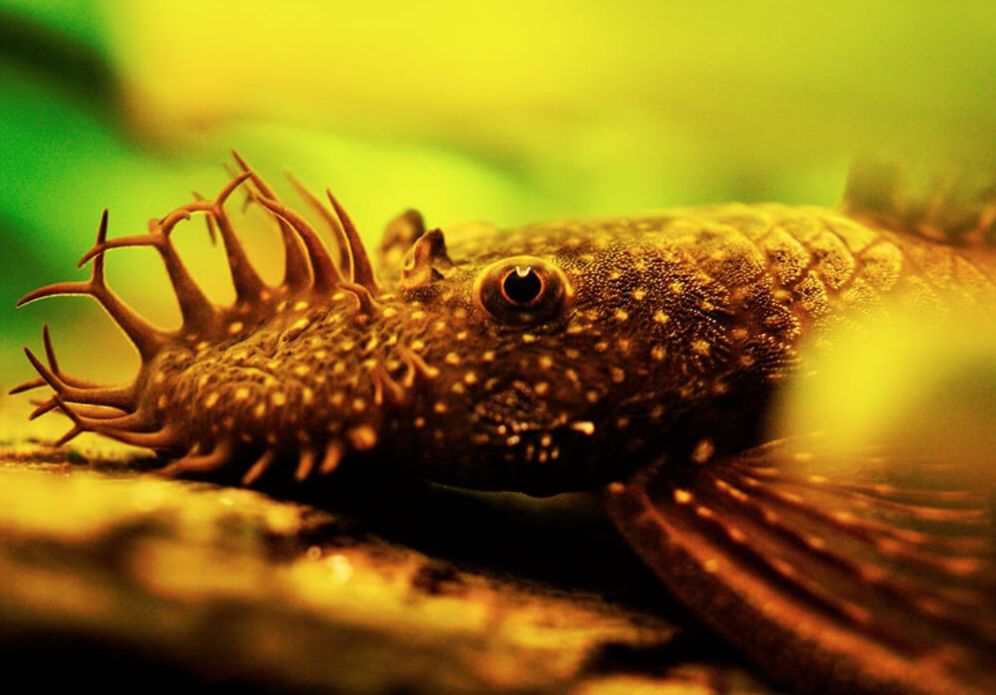
Contents
Habitat in the wild
The bristlenose pleco is native to South America, most commonly found in the Amazon River basin. In the natural habitat of loricariidae catfish, water conditions throughout most of the year include a hardness of 4 to 5 °dH and a slightly acidic pH of around 6. The water in these areas is fast-flowing and rich in oxygen, providing an ideal environment for the species.
In the wild, bristlenose plecos prefer areas with dense aquatic vegetation, including submerged plants, floating vegetation, and algae-covered surfaces. These fish are primarily nocturnal, seeking shelter during the day and becoming more active at night. In aquariums, they maintain these natural behaviors, often hiding in caves or under driftwood when the lights are on. Their adaptability and ability to thrive in different environments make them popular among aquarists.
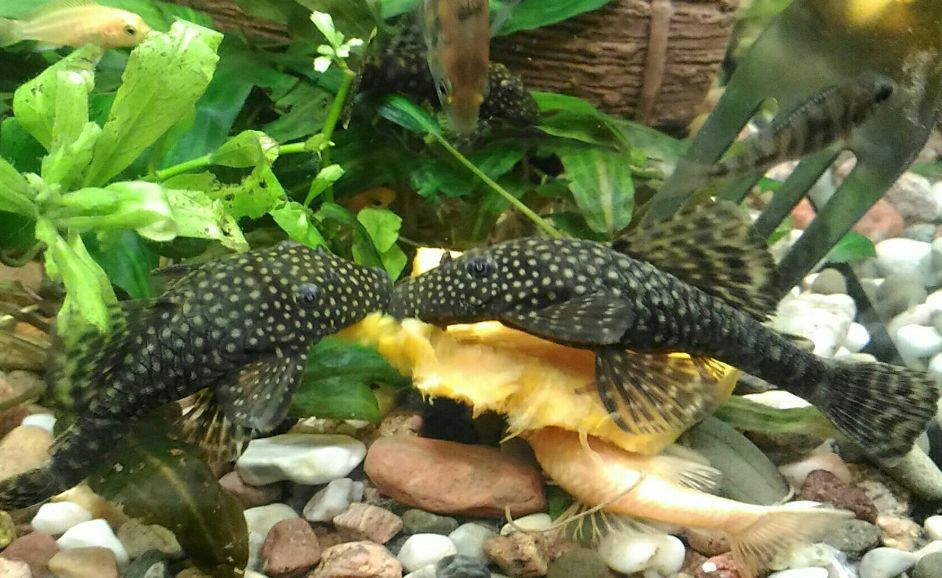
Description
The genus Ancistrus, commonly referred to as bristlenose plecos or bushymouth catfish, belongs to the loricariidae family, also known as the armored or suckermouth catfish. This genus includes several species of freshwater catfish that are popular in the aquarium trade due to their hardiness and algae-eating abilities.
Bristlenose plecos are known for their flattened bodies, which are covered in polyangular bony plates. These plates, although covered by a layer of skin, give the fish a smooth, armored appearance. The skin itself is thick and may feature small, bony tubercles depending on the species.
One of the most distinctive features of the bristlenose pleco is its round mouth and elongated lips equipped with a specialized sucker. This suction ability allows the fish to cling to rocks and submerged surfaces in fast-flowing waters, both in the wild and in aquariums. The “grater-like” horn buds on the mouth’s surface help the pleco scrape algae and biofilm from plants, rocks, and other surfaces, which form the bulk of their diet in their natural habitat.
Their typical coloration ranges from dark brown to grayish, with small bright spots scattered across the body and fins, which often turn into stripes on the fins. The underside of the body is generally lighter than the dorsal side. These colors, combined with their unique features, make them visually striking.
There are two notable variations of the bristlenose pleco:
- Long-finned bristlenose pleco: Selectively bred for their elongated and flowing fins, this variety adds elegance to the already popular fish. Their dorsal, pectoral, and caudal fins are longer than the standard bristlenose pleco, giving them a graceful, eye-catching appearance in aquariums.
- Albino bristlenose pleco: This variation results from a genetic mutation that reduces or eliminates melanin, causing the fish to appear pale or white, with pink or red eyes due to the lack of pigmentation. Aside from their coloration, albino bristlenose plecos share the same care requirements and behavior as the standard variety.
While these varieties differ in appearance, they do not require different care. Both long-finned and albino bristlenose plecos are just as hardy as their standard counterparts and can appear unexpectedly in the spawn of common bristlenose plecos.
Size
The bristlenose pleco is one of the smallest catfish commonly kept in tanks, typically reaching 4 to 6 inches (10 to 15 cm) in length. Even males, which tend to be slightly larger than females, rarely exceed 6 inches (15 cm). Males are often distinguished by the longer, more pronounced bristles on their faces, especially during maturity.
Growth rate
In general, bristlenose plecos have a moderate growth rate compared to other fish species. They tend to grow quickly during their first year, reaching several inches in length from their small size at hatching. However, their growth rate slows as they mature.
The quality and variety of their diet play a significant role in promoting healthy growth. Providing a balanced diet that includes high-quality sinking pellets, fresh vegetables such as zucchini, cucumber, and spinach, along with occasional protein-rich foods like bloodworms or algae wafers, ensures they get the nutrition they need. A well-rounded diet not only supports growth but also contributes to the pleco’s overall health and longevity.
Lifespan
On average, bristlenose plecos have a lifespan of 3 to 7 years. However, with proper care, some can live up to 10 years or even longer. Their lifespan is influenced by factors such as genetics, water quality, diet, and overall tank conditions.
Providing a suitable environment with clean, well-oxygenated water, a balanced diet, and regular tank maintenance can significantly contribute to their longevity. By maintaining stable water parameters and offering a varied diet, you can help ensure that your pleco lives a long, healthy life.
| Characteristic | Description |
|---|---|
| Latin Name | Ancistrus spp. |
| Common Name | Bristlenose pleco, bushymouth catfish |
| Size | Typically 4 to 6 inches (10 to 15 cm) in length, but can vary depending on the individual and species. |
| Lifespan | Average lifespan of 5 to 10 years, but can live up to 15 years or longer with proper care. |
| Appearance | Stocky body shape with flattened abdomen, tentacle-like bristles on the face (more prominent in males), and armored plates on the body. |
| Coloration | Varied colors, including brown, gray, or black with mottling patterns. Albino variants are pale or white. |
| Compatibility | Generally peaceful and compatible with a wide range of community fish, but males can be territorial with other males. |
| Diet | Omnivorous, feeding on algae, biofilm, and vegetable matter. Also accepts sinking pellets and occasional protein-rich foods. |
| Behavior | Nocturnal and secretive, often hiding during the day. May become more active and visible during feeding times. |
| Tank Requirements | Tank size of at least 20 gallons (75 liters) for a single specimen, with appropriate hiding spots and ample surface area for grazing. |
| Water Parameters | Prefer soft to moderately hard water with a pH range of 6.5 to 7.5 and a temperature range of 72°F to 82°F (22°C to 28°C). |
| Breeding | Prolific breeders under favorable conditions, typically breeding multiple times a year. Males guard the eggs. |
| Maintenance | Regular water changes, monitoring water parameters, and providing a balanced diet. Also, maintaining good filtration and a clean tank. |
.
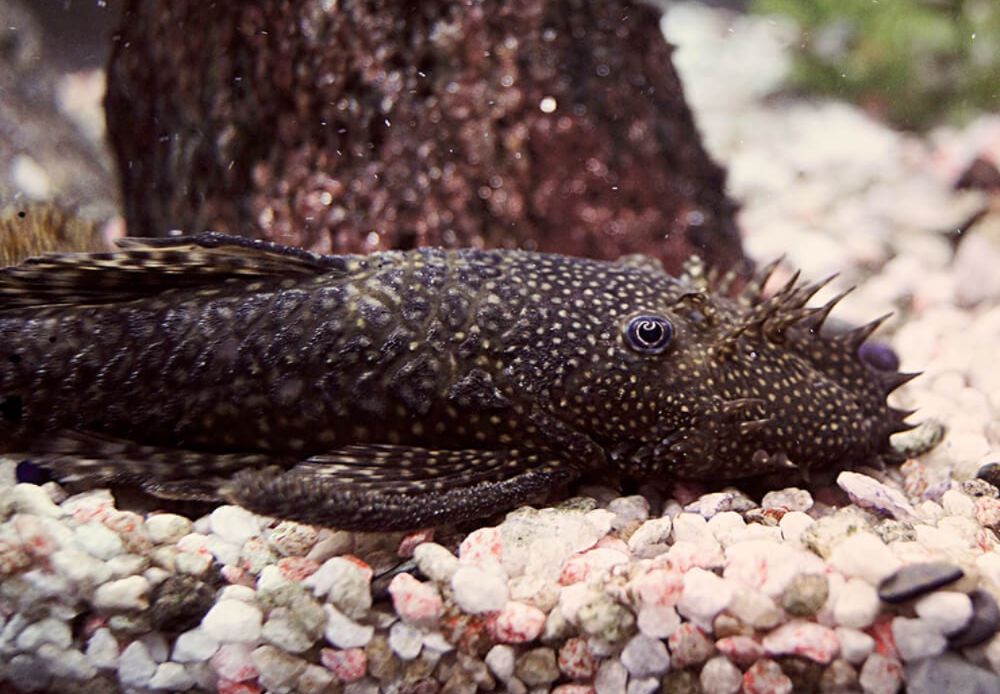
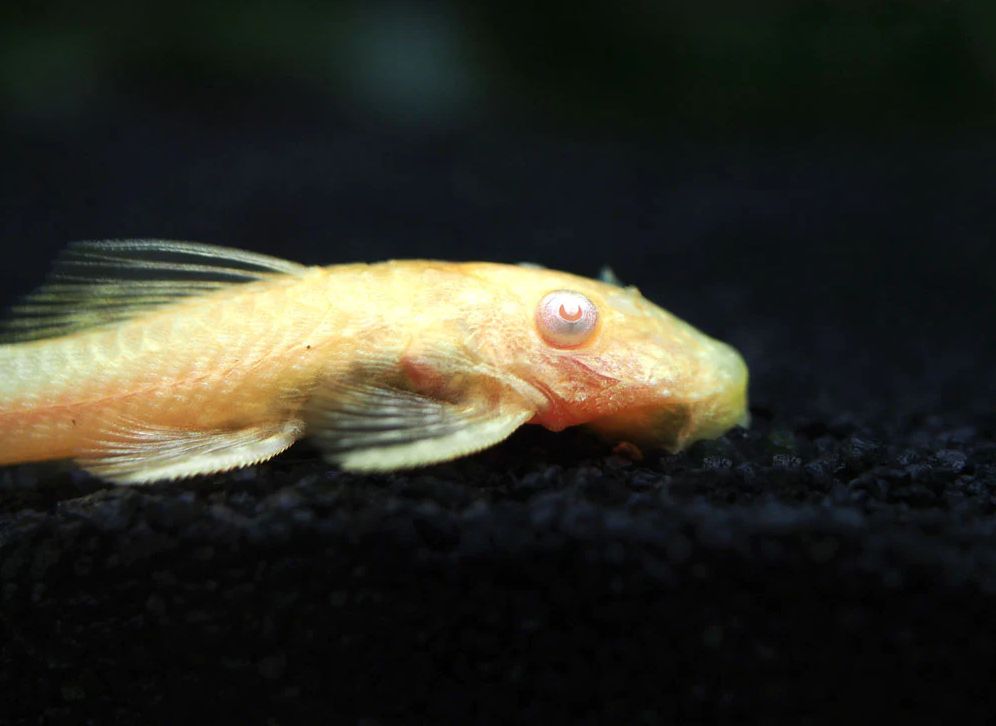
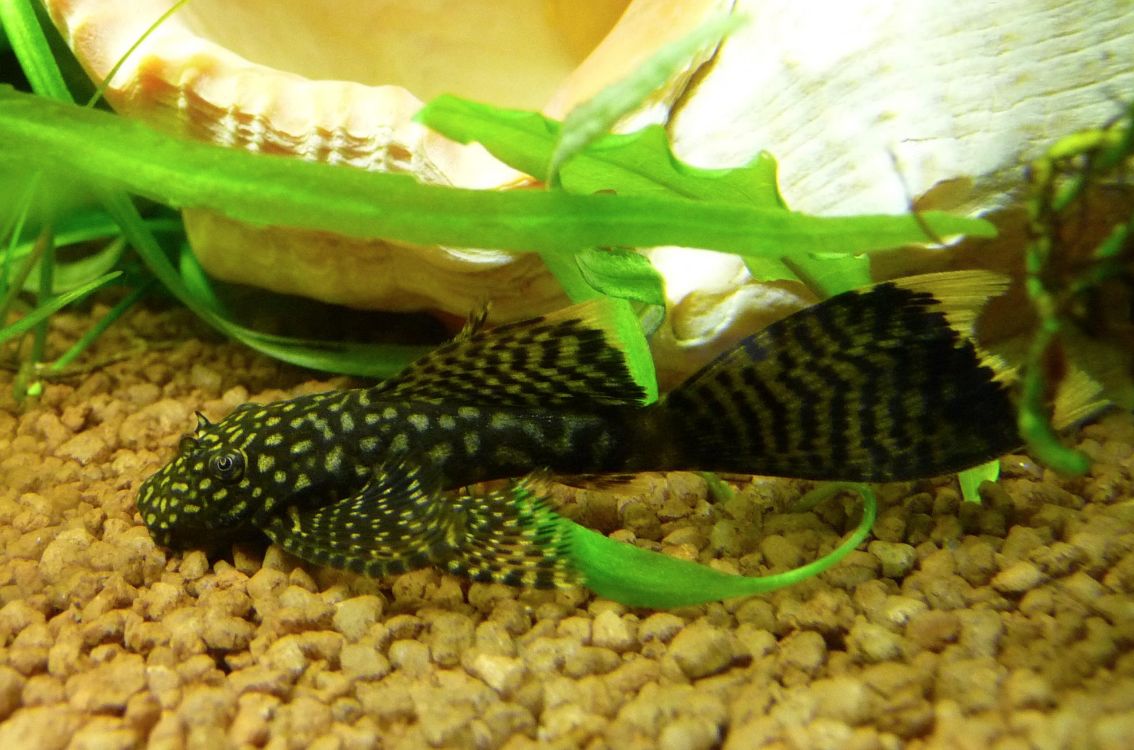
Care and keeping in a tank
Water parameters
To keep bristlenose plecos healthy and thriving in a tank, it’s important to maintain the following water conditions: the ideal temperature is around 24°C (75°F), with water hardness (dGH) ranging from 20 to 25°, and a pH between 6.5 and 7.5.
Regular water changes are essential to maintain good water quality. At least once a week, renew 25% of the tank water with fresh, dechlorinated water. This helps remove waste, reduces harmful substances, and keeps the environment stable for the fish.
Tank size
The recommended tank size for a bristlenose pleco (ancistrus spp.) depends on how many plecos you plan to keep and the available space in your aquarium. While they are relatively small compared to other pleco species, they still need sufficient room to thrive.
For a single bristlenose pleco, a minimum tank size of 20 gallons (75 liters) is ideal. This provides ample swimming space, as well as plenty of surfaces for grazing and exploring. If you plan to keep multiple plecos or house them with other fish, a larger tank is necessary to accommodate the additional space requirements. For each extra pleco, consider adding at least 10 gallons (40 liters) to ensure they have enough room to prevent overcrowding and potential territorial issues.
Tank decor
Create plenty of hiding spots in the tank, such as caves, rocks, or driftwood. Bristlenose catfish are nocturnal and enjoy having secure places to retreat during the day.
Pleco prefers shadowed tank areas which should be taken into account when designing the tank. This fish swims almost all the time looking for some live or plant food leftovers on the tank bottom.
This catfish likes being in the water flow area which is created by the pumps of tank filters. It’s important to keep in mind that the bristlenose pleco may get inside the filter and die, that why it’s recommended to get the filter output tube up at some distance from the tank bottom or close it with some grid.
This catfish gets used to new tank conditions quite easily, and what’s interesting, is that juveniles at the age of 2-6 month adapt faster than adult fish. When buying juveniles you should ask about the tank conditions where they used to live and about the feed they were given there.
Substrate
Use a soft substrate like fine sand or smooth gravel when setting up a tank for bristlenose plecos. These substrates are ideal because plecos often forage along the bottom of the tank, searching for food and grazing on surfaces. A soft substrate helps protect their delicate undersides and prevents injury while allowing them to engage in their natural digging behavior. Fine sand or smooth gravel also makes it easier for beneficial bacteria to colonize, which aids in maintaining water quality.
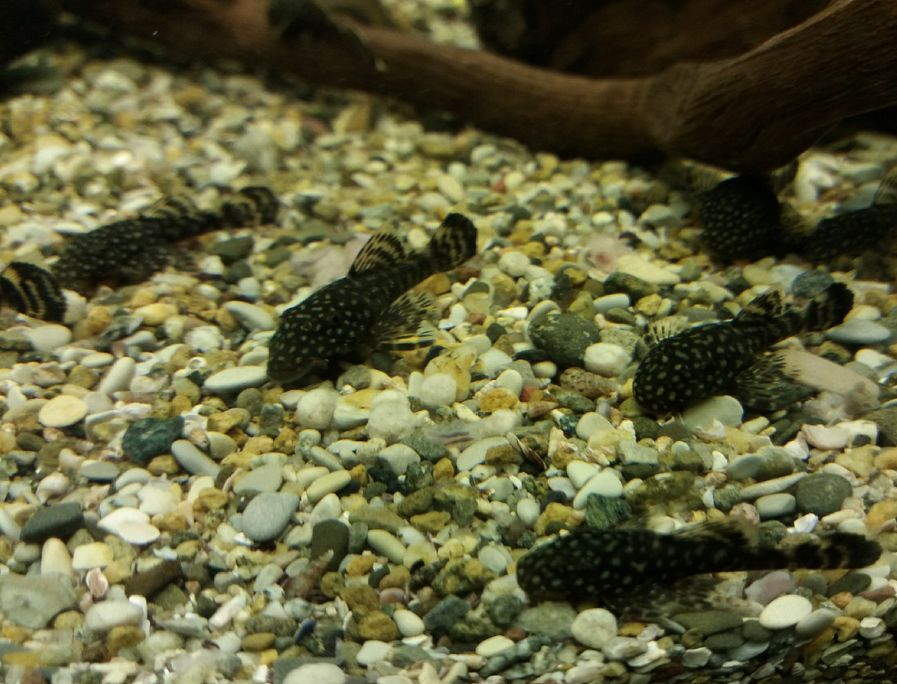
Diet
Bristlenose pleco is considered to be a algae eater. Namely this feature of the cupule makes this catfish an irreplaceable one to deal with fouling on tank glass and decorations. Due to the unique structure of its mouth fish scrapes any small fouling. Thus, we can say that the fish isn’t demanding as for the feed and it can find food on its own. However, this doesn’t mean that the aquarist doesn’t have to feed the fish. Diet has to consist on 70-80% of plant food and 20-30% of protein.
It’s important to have some snag in a tank because by sucking it around the catfish gets lignin, which is important for its digestive system.
When there’s not much fouling in a tank, the bristlenose pleco may start eating tank plants and usually young and soft leaves suffer from this, the fish gnaws holes in them or just eats them completely. To avoid this it’s advisable to give some additional plant feeding to bristlenose pleco. The easiest way is to feed it with some branded food with plant components.
Also you may use some parboiled lettuce leaves (it’s enough to put them into boiling water for 1 minute), or it may be cabbage leaves or a cucumber (cut it into pieces and also put into boiling water on a fork).

Tank mates
The bristlenose pleco is a territory dependent one, however this concerns only the fish of the same kind. Males start fighting for territory and the one that is larger makes the smaller one leave. Some smaller catfish species can be compatible with plecos, such as otocinclus catfish (also known as oOto cats) or smaller species of Synodontis catfish.
Bristlenose plecos can coexist with other bottom-dwelling fish, such as Corydoras catfish (e.g., adolfoi corydoras, panda corydoras) and kuhli loaches. These species occupy different areas of the tank and generally have peaceful temperaments.
Bristlenose plecos usually do not pose a threat to dwarf shrimp species like Cherry shrimp or Amano shrimp.
Is compatible with any fast and active fishes that swim in the middle water layer, including tetras (e.g., neon tetras, ember tetras), rasboras, gouramis, peaceful cichlids (e.g., dwarf cichlids), peaceful barbs, and peaceful livebearers (e.g., platies, mollies, swordtails).
- Harlequin Rasboras (Trigonostigma heteromorpha)
- Neon Tetras (Paracheirodon innesi)
- Ember Tetras (Hyphessobrycon amandae)
- Glowlight Tetras (Hemigrammus erythrozonus)
- Black Neon Tetras (Hyphessobrycon herbertaxelrodi)
- Cardinal Tetras (Paracheirodon axelrodi)
- Rummy Nose Tetras (Hemigrammus rhodostomus)
- Dwarf Gouramis (Trichogaster lalius or Trichogaster chuna)
- Sparkling Gouramis (Trichopsis pumila)
- Celestial Pearl Danios (Danio margaritatus)
- White Cloud Mountain Minnows (Tanichthys albonubes)
- Dwarf Rasboras (Boraras spp.)
- Endler’s Livebearers (Poecilia wingei)
- Guppies (Poecilia reticulata)
- Platies (Xiphophorus spp.)
- Corydoras Catfish (Corydoras spp. – pygmy cory, panda cory, adolfoi catfish)
- Otocinclus Catfish (Otocinclus spp.)
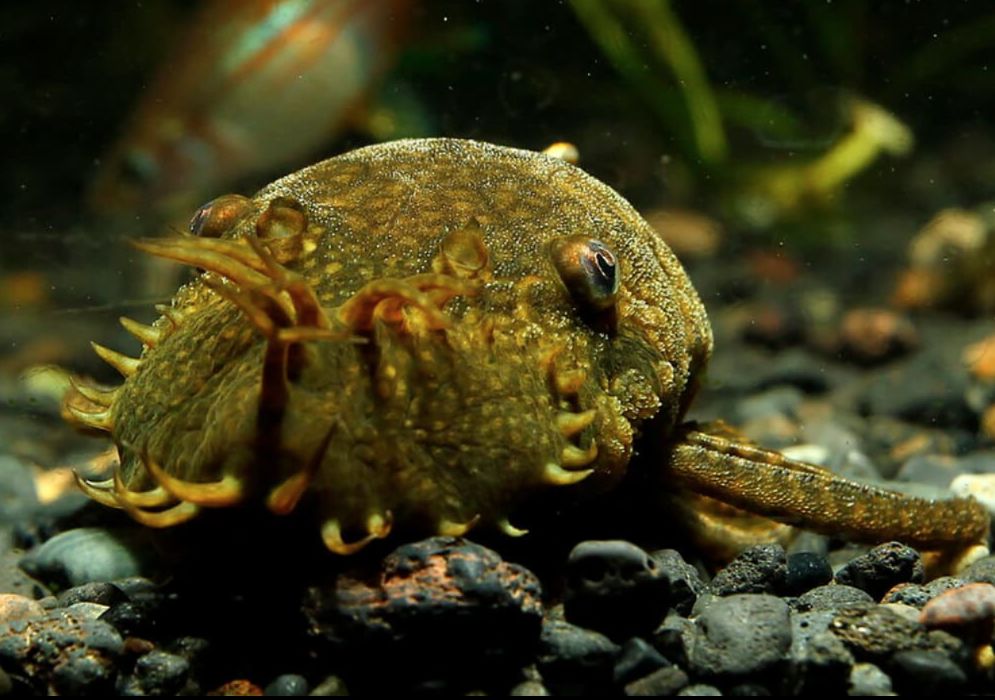
Gender differences: male vs female
It’s relatively easy to distinguish between male and female bristlenose plecos. Males have multiple bristle-like tentacles along their heads, which is a distinctive feature giving them their name. In contrast, females have fewer of these bristles, which are often limited to the edges of their heads and may be less developed or absent altogether.
Additionally, males are typically larger than females and can display more aggressive and territorial behavior. They are known to establish territories within the aquarium, particularly towards other males, and may exhibit more aggressive interactions. Females, on the other hand, are generally more peaceful and less likely to engage in territorial disputes.
Breeding
It’s easy to breed bristlenose pleco, quite often they spawn in a community tank, however, as a rule, their juveniles don’t have any chances to survive in such conditions. Usually the fish lays its eggs in some slits in a tank or in tubes, quite often they may do this even behind the water filter and if they can get inside it, so they’ll spawn there.
In general, bristlenose plecos can breed several times a year, especially when they reach sexual maturity. They are known for their ability to breed readily in captivity. Once a male and female pleco pair forms a bond, they may engage in courtship behaviors, including the male cleaning a potential spawning site and the female inspecting it.
Demolishing the common view that this fish doesn’t have any parental instinct, male eagerly takes care of their eggs and newborn juveniles. After the female lays some bright orange large eggs, the male starts taking care of them by cleaning them with his mouth, dusting them with his fins and guarding from all possible dangers including the female herself.
For purposeful breeding we usually use a separate tank of not less than 20 gallons capacity without any bottom substrate or plants. You should put some ceramic or bamboo tubes, or stones, or snags in it. The moment when the bristlenose pleco is ready to spawn is defined by the level of how female gets fat – if a hungry female looks like an aerostat – so, it’s about time to put her spawning.
The water for spawning tank is taken from the same tank where fish used to live. To stimulate spawning add 1/3 of fresh defecated water into it and decrease the water temperature a bit (about 2 °C lower).
Sometimes the bristlenose pleco start spawning the very next day and more often the male spends several days looking for some proper from his point of view tube or slit and cleans it thoroughly this way preparing the place for his future nest. At the same time you can feed the fish right in the spawning tank and it’s better be some plant food. However, don’t forget to remove food leftovers to prevent them from rotting somewhere in the tank.
Spawning itself usually happens at night. The female lays from about 30 to 200 eggs, their number depends only on the female size and age. So, if it’s her first spawning, don’t expect to get high productivity. The eggs stuck to the surface that was prepared by the male in advance and after that the female is driven out and the male starts guarding his spawn.
The bristlenose pleco female should be taken away from the tank as fast as possible, since she makes the male nervous and he attacks her all the time and may even kill if the tank isn’t spacious enough.
The eggs grow for 4-7 days (it depends on the water temperature, so to speed up the eggs growth you may rise the water temperature after spawning up to 26-28 °C (78-82 F)), and all this time Male continuously guards the eggs without even leaving them to get some food. In case of pleco spontaneous spawning in a community tank you may take the eggs together with the male into some separate volume, especially it’s easy when the spawning has happened in a tube.
If the eggs were laid directly on the tank glass or somewhere behind the filters or stones (this also happens), you should carefully cut it off with a blade and put into a separate volume. Don’t be afraid of the fact that the eggs were exposed to air for some short period of time – this won’t do any harm to them. But in this case don’t put the male together with eggs, since after the stress he has suffered he stops taking care of the eggs and may even eat them.
Large larvae that hatches out have large yolk sac and for several days they stay together in a bunch, after that they start swimming around the tank little by little. Since this moment you should take away the bristlenose pleco male from the tank, too, and give some first food to the juveniles.
You may use different dry feed for juveniles, it’s especially comfortable to feed them with different tablets made for catfish.
The juveniles just stick all over the tablet and gnaw it. Those of them, who didn’t get to the tablet, swim fussy around it and eat some crumbles that fall on the tank bottom and try to get closer to the food source.
Provided with regular feed (at least 3 times a day) and daily water renew ( 20% of all water volume) juveniles grow very fast and at the age of 6 month they become almost as large as their parents are.
The juveniles become adult and reproductive approximately starting from the age of 10 month, so this is also their breeding age.